

‘No-Home Homecoming’ competes with university events
Alumni who feel at odds with the university say Homecoming festivities hold new implications.

Similar to the Aug. 29 rally, alumni against the impending university name change came to protest outside campus gates on Oct. 4 with signs and custom merchandise — getting attention in the form of beeps from passing drivers and coverage from local news outlets.
BY LILY RESLINK & ISAAC FICK
Without university affiliation, alumni organized events separate from Virginia Wesleyan’s 2025 Homecoming Weekend, Oct. 3-5. Alumni planned what they called “No-Home Homecoming” as an expression of disconnection from their alma mater.
“We thought [No-Home Homecoming] was important, since the President wouldn’t speak to any of us directly, ... to sort of make a stand and show that it actually matters, and it’s not just one person, and it’s not just nostalgia; It’s
real, tangible issues,” rally participant Amy Gallup Klann ‘89 said.
Concurrent with campus-affiliated events, No-Home Homecoming invited alumni to gather at Shorebreak Pizza & Taphouse, the campus entrance, Cova Brewing Co. & Coffee House and Scott Memorial United Methodist Church during Homecoming weekend.
Participants largely attributed the disconnect with their alma mater to the university’s name change to Batten University and criticism of administrative leadership.
As part of No-Home Homecoming, alumni gathered outside campus gates on Oct. 4 for the second time after the
While the university said she resigned from the Alumni Council, Kim Mayo ‘98 said she learned second-hand about her removal from the position.

name change announcement. “I’m here to rally with fellow alumni and just to make our voices heard. It’s very disheartening when you kind of built your identity around your college,”
Michelle Asaro Maxfield ‘93 said.
First-year Enrollment Counselor Zion Purvis Allen ‘24 said for those who oppose the name change, “I completely understand where the discomfort could come from, but I’m excited about what this could bring for the years to come.”
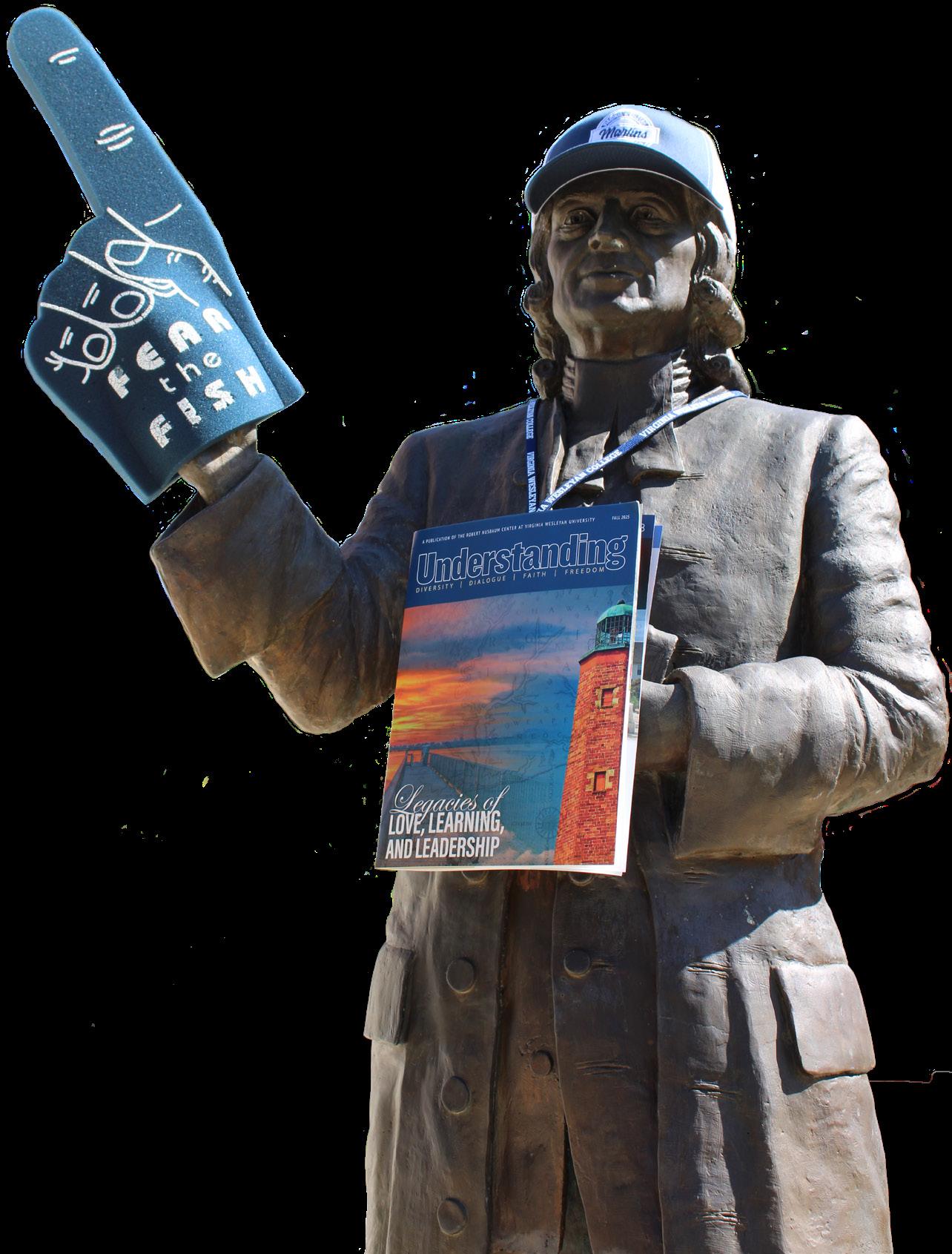
HOCO Page 3
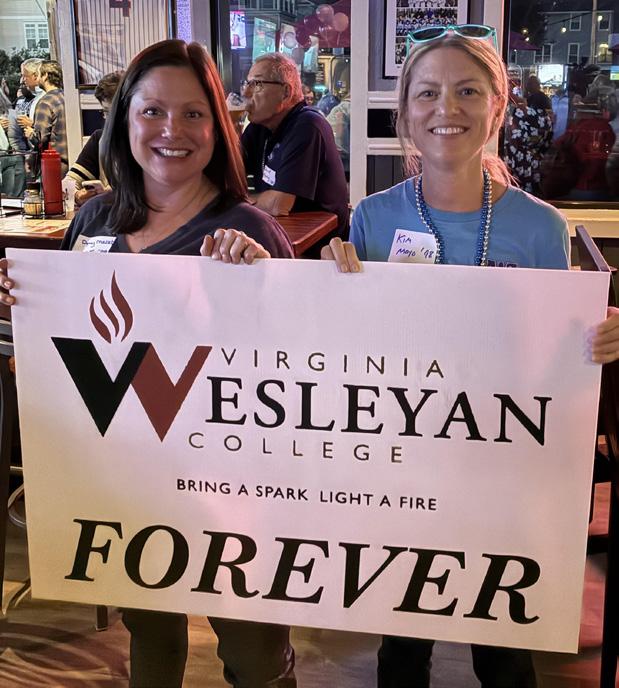
Kim Mayo|Courtesy Kim Mayo [RIGHT] and her classmate meet at Shorebreak for an alumni-organized gathering.

book
BY ISAAC FICK & LILY RESLINK
Former Alumni Council member Kim Mayo ‘98 said she learned that the university website no longer listed her as a member of the alumni council via messages from friends on Oct.
13. Contrary to the university’s account, Mayo said she planned to complete her term on the council.
“I did not resign from the Alumni Council,” Mayo said. “I was kicked off the Alumni Council.” Mayo said she emailed
Chief of Staff Kelly Cordova on Oct. 14 asking why her name was no longer listed. Alumni-run social media accounts shared Cordova’s email response to Mayo, which said her public statements and actions indicated she did not wish to be involved with the university or its future. In the email, Cordova said she accepted Mayo’s recent activity as her “de facto resignation,” and asked Mayo to inform her if this was a misinterpretation.
3
Inside Look:
returns Nansemond Nation artifacts
The Nansemond Indian Nation reclaimed ancestral artifacts held by the university for nearly 60 years in a Peace Garden ceremony on Oct. 23. -- Page 5
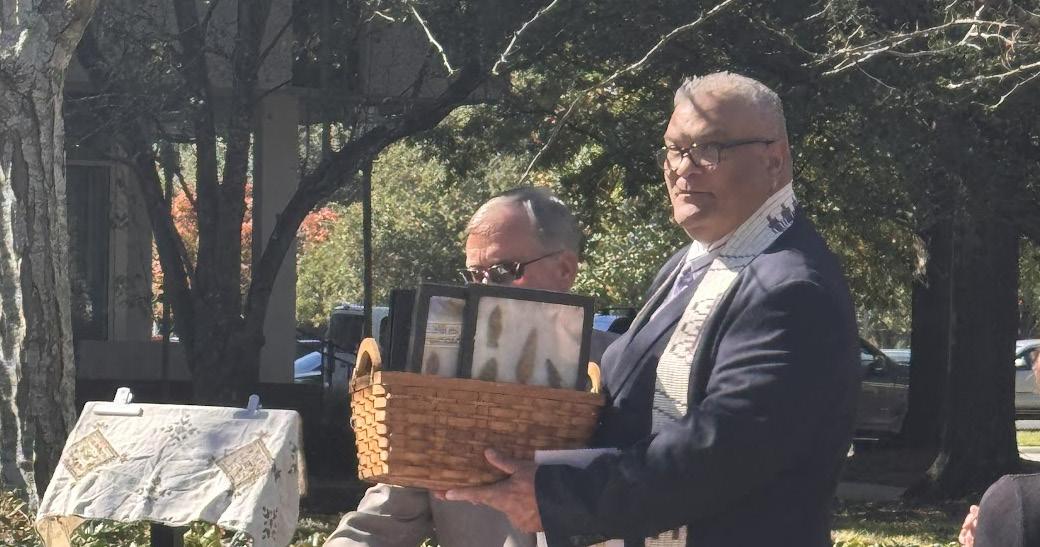
‘Why waste time knowing about yourself?’
Editor Victoria Haneline reviews VWU’s production of ‘The Wolves.’ -- Page 4


Championship or bust?
VIRGINIA WESLEYAN
Carter Kellam|Marlin Chronicle
Austin Smith|Courtesy
Isaac Fick|Marlin Chronicle
university promotes the Sacred Spaces Tour with Drs. Larry Hultgren and Stephen Mansfield on Hoco Weekend by decorating the John Wesley statue on campus.
Jordan Crallé|Marlin Chronicle
See ALUMNA Page
Ashley Cayon|Marlin Chronicle
Laila Jones|Marlin Chronicle
Emilie Dajc|Marlin Chronicle
Putting AI to work
For or against AI, professors agree it is inevitable
BY MARS SMITH rssmith@vwu.edu
With artificial intelligence’s (AI) dissemination into classrooms, professors from academic disciplines ranging from philosophy to the visual arts have taken on various tactics to confront its presence.
“Whether we like it or not, it’s going to be the prevailing technology of the future,” Associate Professor of Digital Art Derek Eley said.
“If we want to be seen as people that understand it, and if we want to be able to introduce it [to curriculum in colleges], just like with any burgeoning technology, we have to be early adopters,” Eley said.
Similarly, Levi Tenen, assistant professor of Philosophy and coordinator of the Ethics Bowl, said “there is an inevitability built in,” comparing the increased usage of generative AI to the printing press and cars.
Tenen does not allow students to use AI for idea generation, including outlines, theses and arguments. Additionally, sources have to be real sources, not AI. “I’m a philosopher, and I feel like that’s a discipline, maybe more than anywhere else, where people’s ideas are what matter,” Tenen said.
“AI tools like Grammarly and ChatGPT, or any AI editing software, are considered academic dishonesty by the English department because they undermine students’ ability to write their own ideas,” Jennifer Slivka, associate professor of English, said.
As such, Slivka has gone with old school pen and paper journals to combat the growing usage of AI in higher education, citing that studies have shown that information retention is often higher when students take notes by hand rather than typing.
Survey data from Sept. 30 by Inside Higher Ed discovered that “the average student who uses generative AI does so to get a direct answer, not to learn.”
“I want the work that comes from me to be my words and my words only,” senior Amalia Houff said. She does not use AI and therefore said it does not affect her academic integrity.
Freshman Caddy Lang uses AI programs for studying, finding sources and organization.
“Honestly, since getting into college I haven’t noticed much AI usage among my peers,” Lang said. Tenen said AI tools like

ChatGPT and Grammarly can affect students’ academic confidence and integrity. “Somebody who uses AI basically tells me that they’re not important enough to be listened to on their own. They don’t have good enough ideas, or they’re not working hard,” Tenen said.
“I definitely think that there are larger implications for people who don’t really understand how to write using their own voice and heavily rely on AI,” Houff said. “They become unable to do timed written exams or truly
fix an awkward sentence,’ but it’s a slippery slope,” Slivka said. “If given the chance, [AI] can write the whole paper for you.”
Eley does not share the same outlook. Eley’s tactics for confronting the presence of AI requires students to learn how to utilize specific AI programs on some level.
“It’s hard not to, especially with a generation that uses it increasingly more often for things outside of school, but my advice is just don’t use it.” Slivka said.
“[AI] gets people to
AI’s employment threatens jobs
As AI works its way into workplaces, campus community members discuss the implications.
BY BRUCE BLANCHARD bcblanchard@vwu.edu
Students and faculty consider what the future holds regarding jobs and internships with artificial intelligence (AI) becoming increasingly advanced.
Assistant Professor of English, Dr. Sara Ryan said that AI has become something she frequently sees used by students, and fears that it can become rather detrimental for students in the future when stepping into professional settings.
Referencing her college internship as an administrative assistant, Ryan said, “I copied documents and organized them into files and put them into files. That was my internship all summer, and AI does that now.”
She said paying humans is no longer needed for this task. “I could see many of these entry-level positions start to phase out, as AI is now taking their place. Not only that, but entry-level experience will begin to mean less because AI can do that now,” Ryan said.
The fear of AI replacing jobs and internships is growing. Company managers decide if AI works its way into a workplace. In a study by global software firm Trio.dev, 3,005 managers were asked the question: “If they could, would your boss trade you for AI?” Over one in five Virginia managers said yes, with 21% openly admitting to feeling no guilt about it.
For some managers, small savings are enough to make the decision. 15% said they’d replace an employee for as little as a 5% cost cut. Although, on the other end of the spectrum, half of the respondents said they’d only make the switch at a 50%

raise the question of what jobs should and shouldn’t be replaced.
A national survey of 4,012 people by global software firm Trio.dev found that 92% of Virginians believe some jobs should always remain in human hands, no matter how advanced AI becomes, with doctors and surgeons being number one on the list.
“I’m trying to go into the medical field, and I think there’s definitely ways that AI with scientific aspects will try to take over in a sense, and I definitely don’t think for the medical industry that will be a good thing,” freshman Psychology major Gabby Ismerk said. She said she has observed AI gradually making its way into the field. The study also asked Virginians which qualities AI can never replicate, to which the respondents pointed to empathy (39%), common sense (22%), and ethical judgment (17%).
Freshman Art Education major Cady Martin said AI has other limitations while affecting artists by replicating their work. She said she feels that AI teaching art is limited, “especially since I want to go into ceramics, which is something AI can’t teach people.”
With promises of efficiency, most Virginians from the study still want technology to assist, not replace, with 65% saying they’d prefer a human worker even if AI could do the job more accurately.









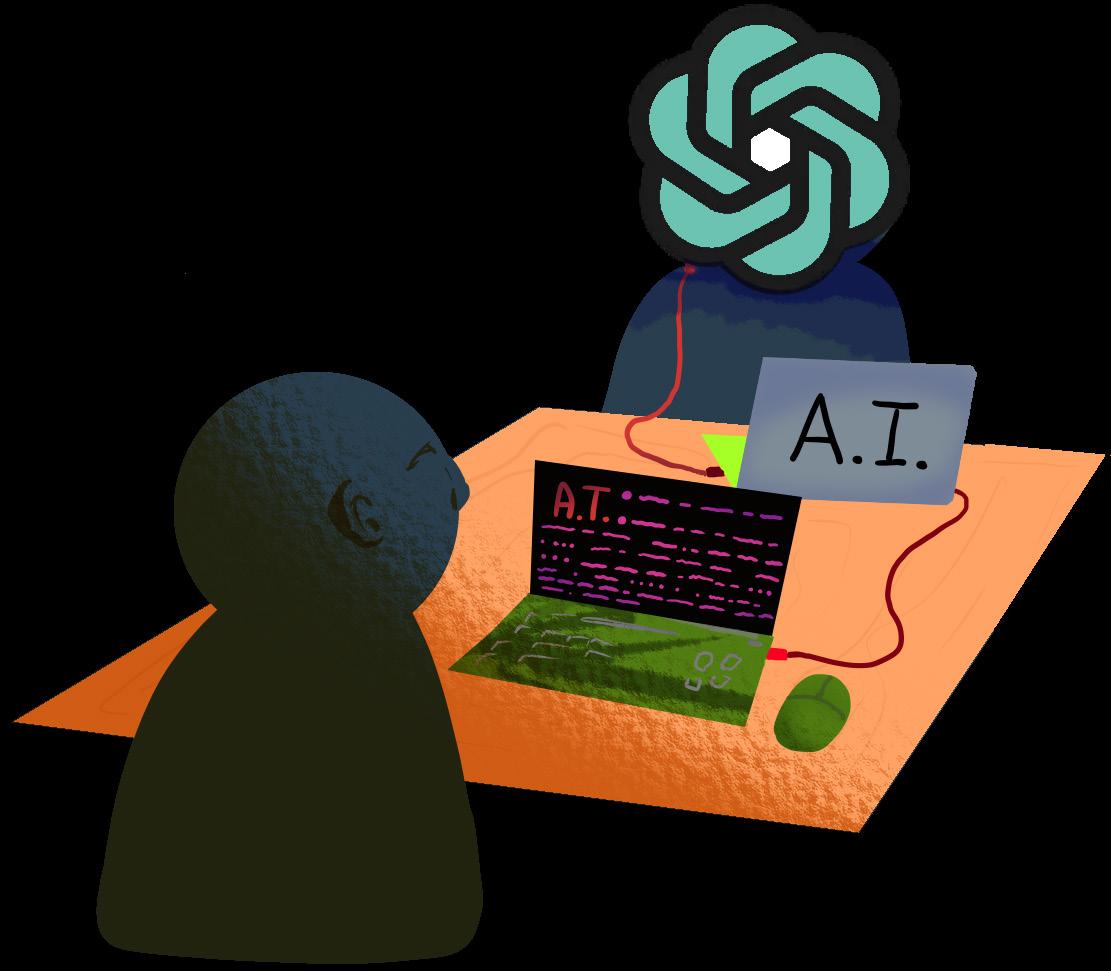
Isaac Fick|Marlin Chronicle
Devin Cowhey ‘10, leader in coordinating No-Home Homecoming and alumni mobilization against the name change, said for around 15 years Virginia Wesleyan has hosted a Homecoming gathering at alumni-owned Shorebreak Pizza & Taphouse. “It wasn’t on the schedule this year,” Cowhey said. Instead, alumni reserved the restaurant for a No-Home Homecoming dinner on Friday, Oct. 3.
While Cowhey can’t confirm if VWU intended to make their usual reservation, she said Shorebreak was “holding it for the college, and they hadn’t heard any confirmation.”
Regarding off-campus events, “because our campus is located in such a metropolitan area, Marlins have gathered outside of official campus events for forever,” Director of Alumni Engagement Kayleigh Poggioli said.
“We had an amazing turnout [at Shorebreak on Oct. 3]. I think it really shows that there is a problem with this name change, and we’re really concerned about it,” Debbie Kelleker ‘82 said.
Bob Valvano ‘79 said more than 200 attended the Shorebreak dinner. “You should be trying to figure out how you can galvanize those people, not alienate them. Isn’t it just good business?”
“They don’t have to do
anything, but they should give some indication they hear us — not just dismiss us as ‘meanspirited’ or ‘un-Wesleyan-like,’” Valvano said.
“I was super involved with the college after I graduated,” Janet Adams ‘90 said, including membership of the Alumni Association Board of Directors in the late ‘90s and early 2000s.
Adams said she contrasts current university changes to the college’s process of changing their tagline to “bring a spark, light a fire.”
“There were months of surveys and focus groups and contacting alumni and different groups and getting feedback just for a tagline. We’re changing the entire name of the university, and none of that happened,” Adams said.
In an interview with the Chronicle, President Scott Miller said “there were 52 individuals that were considered major stakeholders in the university that were interviewed in 60 to 90 minute interview sessions between December and February,” and all were in support of the change.
As a student-led organization to connect alumni to current students, Junior Miles Pifer is the project leader and incoming president of the Undergraduate Alumni Association, launching Spring ‘26.
Pifer said the association aims to connect alumni to the university.
“The way that we connect even more is at the personal level. It’s never all the way at the top. It’s right on the field, with all of us

within these tents,” Pifer said.
Pifer attended VWU Homecoming events before he was a student, and said it is beneficial for gatherings like this to connect people over shared experiences, such as participating in the same sports team or organization.
Valvano said he found the NoHome Homecoming events to be an impactful bonding experience:
“It’s not just ‘let’s have fun.’ ... there was a purpose behind it.”
Valvano said he does not usually
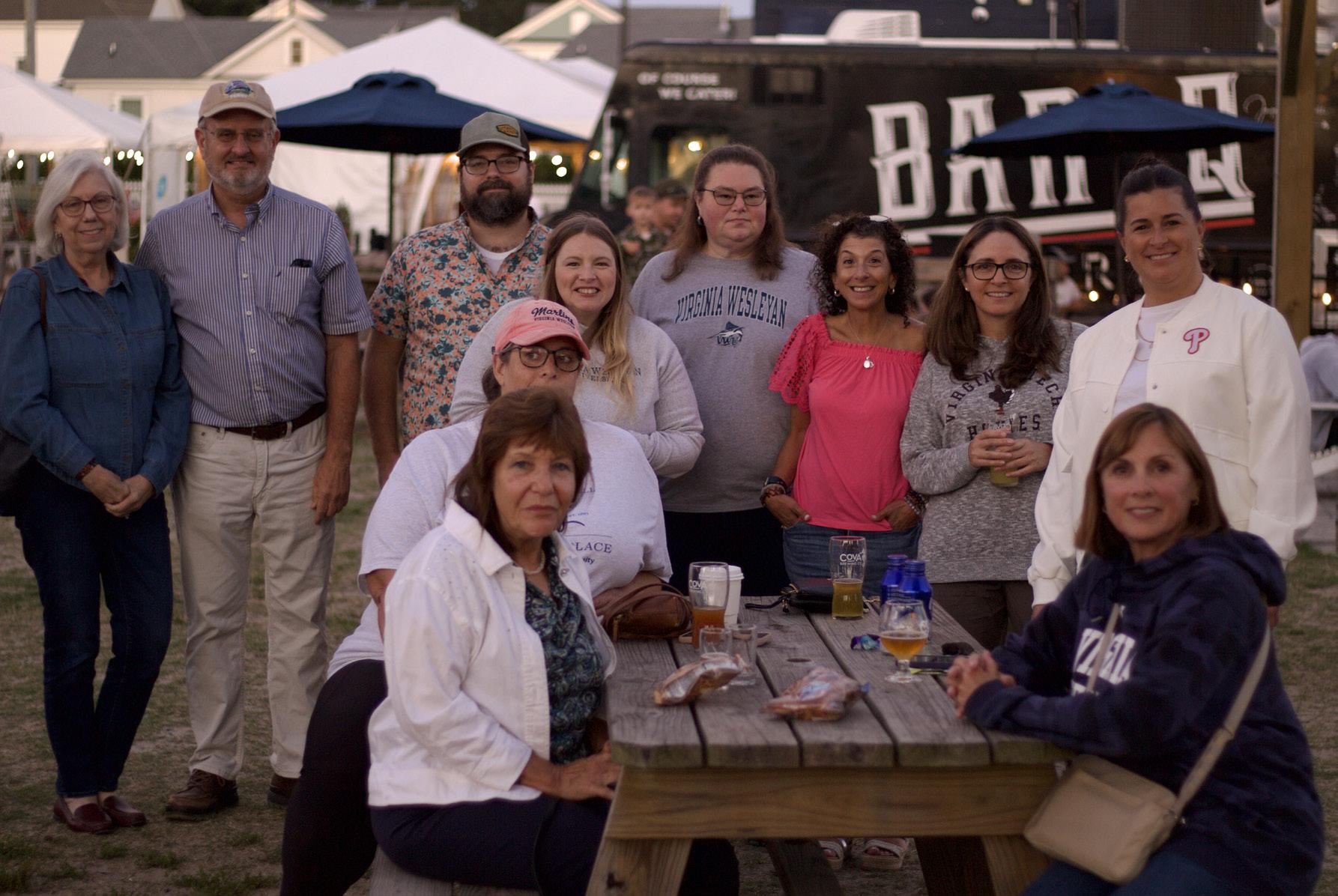
of Alumni Council members.
email. She didn’t.”
According to Cordova, “On Oct. 3, Ms. Mayo directly informed a senior officer within the VWU Trinder Center for Advancement that she was resigning from the Alumni Council, but said she wished to ‘make a statement’ first. She declined to volunteer during the university’s Homecoming & Family Weekend activities (Oct. 4), as all Council members were asked to do, and instead joined the ‘NoHome’ Homecoming events.”
“We interpreted that to be the statement she referenced, and that Monday (Oct. 6), we accepted her de facto resignation, per her discussion with the Advancement officer,” Cordova said.
According to Executive Director of Marketing and Communication Kristina Raines, Director of Web Services Michael Skipper was asked to remove Mayo’s name from the website on Oct. 6 and updated the list that day.
“We considered the matter closed,” Cordova said. “Ms. Mayo had the opportunity to set the record straight by responding to my Oct. 15
“All I know is I never resigned from the Alumni Council,” Mayo said.
“If I had resigned from the Alumni Council, why would I have sent a message asking why I wasn’t on the website?
“If I had resigned from the Alumni Council, I would know I’m no longer on the council, then I wouldn't have gone to the media,” Mayo said. “It wouldn’t have been a story.
“We’ve never met,” Mayo said, regarding Cordova’s email, “I don’t know how she could make the determination whether I was on campus or not, or making statements about resignation.”
Mayo said she attended the homecoming weekend play, as well as the Shorebreak dinner on Oct. 3 and rally in front of campus on Oct. 4. “They were all really good gatherings, and as an Alumni Council member, that’s my duty, in my opinion, to serve alumni, and that’s what I did,” Mayo said.
Mayo said, to her knowledge, that participating in official university homecoming events is not an official expectation or requirement
“I highly doubt that every member of the Alumni Council was on campus for the Alumni Weekend,” Mayo said.
In the bylaws of Alumni Council members document, it reads: “As a volunteer advisory group, the principal purpose of the Alumni Council is to strengthen the bond between alumni and Virginia Wesleyan University, its students, faculty and administration.”
In the general roles and responsibilities document, it reads: “To avoid any relationships that could be perceived as injurious conflicts of interest to those of the University,” and “to refrain from actions and involvements that might prove embarrassing to the University and to resign if such actions or involvements develop.”
Mayo said on Oct. 16, “I emailed Alumni Council members to the best of my ability, some of them had dropped off, and there’s some new ones who I don't know, but I email the contact information I had and copied President Miller, as well as some other administrators, just clearing the air on the false statements that were made.”
Mayo said she emailed
participate in Homecoming, but he flew in from his home in Kentucky to be there because it “meant that much” to him.
“We are glad to see alumni continuing to find ways to come together and celebrate their shared experiences and connection to the university,” Poggioli said. She said university Homecoming events were well attended.
As Homecoming is a primary time for giving, alumni voiced the financial impact of their detachment from the university.
Gallup Klann said she wants “to understand how such an important decision could be made with… no discussion among key stakeholders, including thousands of alumni, many of us who have estate plans to leave significant amounts of money to this college or university.”
“If the name changes to something that has no relation to us ... then we’re going to have to pay money to change our legacy estate donations,” Gallup Klann said.
“I do contribute every year to the ‘excellence fund.’ I will not be contributing another dime when it changes to Batten University,” Maxfield said.
Valvano said the Virginia Wesleyan community once felt like being a part of something bigger than himself. “Now, they want to take that away, and it’s very, very hurtful to a lot of people,” Valvano said.
Valvano pointed to the college’s
early days, where he said it had few resources, but the people had lots of love for each other. “There are people making this decision that weren’t here at that time,” Valvano said, adding that he knows this has been repeated, but he maintains that it is important. “They don’t understand that. They don’t seem to want to understand it. And that’s what’s really offending some people.”
“We didn’t feel like we were very important [to the university],” Suzy Brett ‘72 said, which is why she participated in No-Home Homecoming.
On behalf of her and her husband, Tom Brett ‘71, she said she feels like her board position with the college and their accolades on the wall no longer mean anything.
With other No-Home Homecoming attendees, Brett said she is a part of a cohesive group. “We love each other. We love the college, but we have something that we’re challenged to work toward over there,” Brett said.
Some made themselves at home both on and off campus during Homecoming weekend. While participating in the rally, Gallup Klann said, “We’ve been part of what built this from nothing, and we love it, and I still am going to go on campus today.” Gallup Klann said she still loves to look around the bookstore and check on campus updates.

President Scott Miller on Oct. 18 about the situation. Her email asked if she will be placed back on the Alumni Council and said “More major media outlets want to cover this. I did not resign. I’ve been a strong advocate for alumni, transparent with VW leadership.”
“I’ve held Virginia Wesleyan very close to my heart through the years. I live close to the school. I’ve been very active, not just with Alumni Council, but going to plays on campus, supporting my sports teams as a huge fan of the program, going to parties — just very, very involved.”
“I’m really disappointed that this is how they would treat one of their
own, and I think there's a lot of disconnection, big picture, between many of the alumni as well as the current administration.”
In a statement to the Chronicle, Cordova said, “Alumni Council members are appointed by the university to be advocates for the university and offer support for the enrollment and advancement programs of a growing, dynamic institution. The Bylaws and General Roles and Responsibilities for the Alumni Council act as a handbook for the volunteer role.”
Although Mayo said she is not entirely sure, she traced the sequence of events which she believes led to her departure from the Alumni Council.
“I think that the fact that I was quoted in the VirginiaPilot shortly after the name change was a strike against me,” Mayo said.
“I'm just hopeful for maybe some major changes at the university, in a fresh direction and really leadership who has good communication skills and who value our alumni base and can unify and solidify our relationships between the administration and the alumni base,” Mayo said.
“I’m saddened by what's happened, but I’m hopeful for brighter days ahead,” Mayo said. Mayo said she is still not clear on what caused disagreement surrounding her intent to resign.
Isaac Fick|Marlin Chronicle
Future President of the Undergraduate Alumni Association, junior Miles Pifer [RIGHT] and Director of Alumni Engagement, Kayleigh Poggioli [LEFT], enjoy the Fin Fest at a tent representing VWU’s Trinder Center for Advancement team.
Laila Jones|Marlin Chronicle
Alongside 'No-Home Homecoming' primary coordinator Devin Cowhey ‘10 [TOP RIGHT], alumni gather at COVA Brewing Co. & Coffee House on Oct. 4.
Isaac Fick|Marlin Chronicle
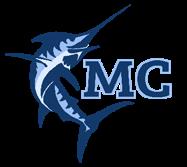
The MARLIN CHRONICLE
Editor-in-Chief
Lily Reslink lbreslink@vwu.edu
Managing Editors
Victoria Haneline vfhaneline1@vwu.edu
Isaac Fick ihfick@vwu.edu
News Editor
Isaac Fick ihfick@vwu.edu
Community Editor
Kami Whisenhunt kjwhisenhunt@vwu.edu
Opinions Editor
Isaac Fick ihfick@vwu.edu
Sports Editors
Coy Camiscioli clcamiscioli@vwu.edu
Eli Casey emcasey@vwu.edu
Weekender Editor
Calee Lukowski crlukowski@vwu.edu
Photo Editor
Laila Jones ljjones1@vwu.edu
Online Editor
Lillian Glenn adglenn@vwu.edu
Copy Editors
Victoria Haneline vfhaneline1@vwu.edu
Elena Lichtenwalner eclichtenwalner@vwu. edu
Julia Ware jpware@vwu.edu
Tehera Clifton tclifton@vwu.edu
PR Director
Isabella Grosswiler idgrosswiler@vwu.edu
Marketing Coordinator
Bryant Cotterell bccotterell@vwu.edu
Engagement Editor
Sarah Czapp sczapp@vwu.edu
Digital Design Editor and Outreach Coordinator
Gabrielle Barnett gabarnett@vwu.edu
Adviser
Dr. Lisa Lyon Payne lpayne@vwu.edu


‘Why waste time knowing about yourself?’
Teenage angst, pregnancy scares and grief are brought to life in ‘The Wolves’ by
Sarah DeLappe, directed by Trey DelPo.

BY VICTORIA HANELINE vfhaneline1@vwu.edu
Curtains open onto a stage littered with soccer balls, duffel bags, backpacks and Gatorade water bottles. This is the first and only location in “The Wolves,” a play by Sarah DeLappe and directed by Trey DelPo, director of the Susan S. Goode Fine and Performing Arts Center, performed Oct. 2 to 5.
The play runs for an hour and a half without an intermission. The entire drama takes place directly before and after games that the Wolves, a Girls Indoor Soccer team, play. Because of this structure, the play is dialogue-heavy and does not have a conventional plot.
“It was definitely different. You had to listen a lot more,” Dr. Sara Ryan, assistant professor of English, said. She said she liked the dialogue-heavy nature of the play and that it was centered around one location.
There were 10 actors involved in the play, and six of them were freshmen, which is more than usual for a play at Wesleyan.
“I fell in love with the story of the Wolves. It’s so complex but it looks so simple,” Rachel Nozzarella, a freshman, said. She played #2, a jersey number, which was how most of the cast was identified. She was proudest of crying onstage in the last scene, and said she had always appreciated her skill of “being able to convey grief.”
Nozzarella and all of the other actors did a good job at the showing on Saturday. Especially compelling performances were Tiffanie Heng, who played #00; Leah Hilliard, who played #25; and Abigail Wigginton, who played #13, although all performed well.
Dr. Sally Shedd, Batten professor of Theatre and Gender, Women and Sexuality studies, played Soccer Mom. She said she enjoyed acting and that this cast grounded her.
“I don’t have a lot of time to act because my job is to direct here,” Shedd said, who thought the last time she acted was in “Legally Blonde” about six years ago. She said she thought acting
made her a better director and that she liked to learn from other directors.
“[DelPo] knows when to have fun and when to get down to business,” Shedd said. She said he was also good at knowing what good motivational food was, and brought in food when there was going to be a late night.
This performance was DelPo’s first at Virginia Wesleyan since he was a student here. He was directing one this year because there were “so many students who wanted” to participate in theater and the two performances a year (one by Travis Malone and one by Shedd) no longer met student demand. This will be a permanent arrangement going forward, great news for theater fans at Virginia Wesleyan.
“We’re all very excited with the direction this theater is going,” DelPo said, referring to himself and the theater faculty. DelPo acquitted himself well, being well liked by his cast.
The show itself was funny and deathly serious at intervals. There were some funny scenes, like when #13, played by Abigail Wigginton, argued that killing hundreds of thousands of people isn’t (morally) complicated #7, Jadyn Espy, responds with “I mean, it is probably pretty challenging.” Another moment was #46, Gabie Isenburg, saying “Yeah, I have lots of secs” in response to being asked if she had a sec, or #13 telling #11, Julia Logue: “You have got a hot mom. That’s the cards you were dealt.”
Despite that, the show was complex and knew when to be serious. It confronted themes of death, both of parents and of teammates, competition between teammates and sexual assault.
“There’s so many other things to know about / why waste time knowing about yourself?,” Brianna Massenburg as #8 asks.
“I really liked how it highlighted the importance of teams and found families,” DelPo said about the play. He added that he liked that it was a show that they could have so many freshmen and young students in.
“The thing that I’m happiest about is the
team that all of the women onstage became,” DelPo said. He said that if he had more time, he would work on the actor’s soccer skills. He said that actors were not cast on their ability to play soccer, a decision that definitely showed.
The show had a few issues. For one, the actors all wearing the same jersey and sweatshirt, which while accurate for a soccer team, complicates character identification. Since it can be difficult for viewers sitting far away to see faces, outfits often help aid in distinction. The main difference in the costuming was the jersey number, but actors do not often have their backs to the audience.
Additionally, the strict adherence to the location, while an interesting writing restriction, has some flaws in plot continuity. The plot that develops in the latter half of the show begins when #14, played by Emilie Dajc, is killed in a car accident. This moment is not shown, and this begins with a few players gathering and wondering if six players would show up, so they wouldn’t have to forfeit. However, an anxiety dream by #00 directly precedes this moment, which, although performed very well, also departed from the rules. I originally thought that she had committed suicide, and that’s why the players might have stayed home.
The show being so dialogue-heavy is also difficult when the words become hard to understand, which happens especially near the beginning when many players are having concurrent conversations.
Despite these minor flaws, it was a touching play that was performed well. The camaraderie between the people involved in the play was especially strong according to DelPo and Shedd. The performance was admirable and a good showing for DelPo’s first play at Virginia Wesleyan. The theater community looks forward to many more.
Shedd is directing the next play, “The Thanksgiving Play,” in November. Performances will be Nov. 14 to 16. All performances are free for students, staff, faculty and alumni.

Pie in the Face
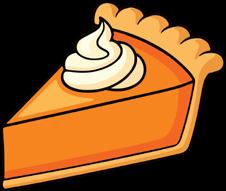

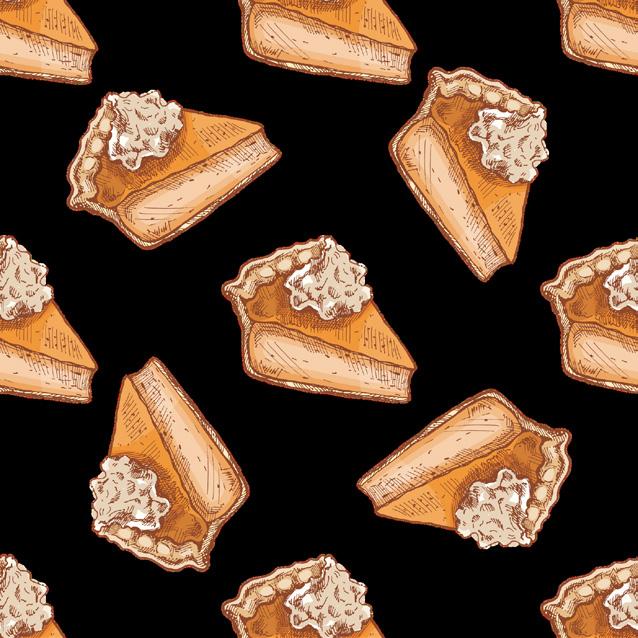
Meet Jana Cowan: New Assistant to the Senior Vice President
BY GABRIEL BAUBLITZ gabaublitz@vwu.edu
Jana Cowan, born and raised in Virginia Beach, VA, has stepped in as the new assistant to the Senior Vice President Dr. Keith Moore.









In this position, she mainly serves as a connection between Moore and anyone he meets with, while also supporting campus projects including graphic design.
With her sister in the office right across the hall from her own, Cowan entered this position with strong connections to the community, but she said she aims to get even more connected.
Cowan listed some of her goals in the role for the 202526 academic year: to understand her role better as she enters a new positon, support Moore, strengthen connections around campus and help with the transition of the name change to Batten University.
Cowan has been on the job for nine weeks so far, including one week of training, and said she’s loving it so far. She graduated from James Madison University with a degree in media arts and design, concentrating in digital video and cinema with minors in Italian foreign language and British media and communications.
Cowan’s sister, Elle, works in the finance office and happened to be nearby when Moore mentioned the job opening. Beyond her sister, Cowan has personal ties to Virginia Wesleyan through some of her high school field hockey teammates who attended VWU,
and her friendship with Michelle Hedspeth, director of Student Accounts.
Cowan’s favorite hobbies include reading, listening to music, photography and exercising, especially running and weightlifting. She has been a personal trainer and coach since she graduated from JMU.
Cowan also spoke about what it’s like working with Dr. Keith Moore.
“It’s very fun. He is very fastpaced. He’s a natural educator,” Cowan said. He definitely challenges me to learn new things, but he has no problem sitting down with me for a couple minutes and being like, ‘Okay, you don’t understand this. Let me walk you through it.’ So he’s very understanding,” Cowan said.
Elle Cowan said that she is very happy to be working in the same building as her sister.
“Her office is right across the hall, so it’s fun to get to see her every day. We have lunch together almost every day. We go on a walk after lunch, and it’s just been really nice having her here,” Elle Cowan said.
“I’m just really proud that she came in from day one and just really embodied what Virginia Wesleyan has to offer,” Elle Cowan said. “She already, from the first day, had so much school spirit, was already making so many connections with people on campus and networking, saying ‘hi’ to people when we were walking around.” She said the job opening “kind of fell into place” after the
previous assistant left and Moore started looking for someone new. Knowing Cowan’s background, enthusiasm and personality, Hedspeth thought she’d be a great fit for the role.
“Well, I think Jana’s background of being an athlete, being maybe close to the students’ age, will give her a good angle on connecting with them, relating with them, but she’s also very professional, so working with the rest of the other colleagues on campus is, I think, how she’s going to be a real success here,” Hedspeth said.
Hedspeth also mentioned that the Cowan family has deep roots in the Virginia Beach community, especially in local sports and through Catholic charities.

Laila Jones|Marlin Chronicle
Left to right: Emilie Dajc, Jaydn Espy, Abigail Wigginton, Brianna Massenburg, Julia Logue, Rachel Nozzarella and Tiffanie Heng.
Jana Cowan|Courtesy Jana Cowan graduated from JMU with a degree in media arts and design.
Isaac Fick|Marlin Chronicle Arranged by Gabrielle Barnett.
Virginia Wesleyan returns Nansemond Nation artifacts
BY ASHLEY CAYON acayon@vwu.edu
Centuries ago, VWU was Nansemond territory, where families fished and gathered on the same land that is now Virginia Wesleyan’s campus. Later, it became farmland, and in the years after emancipation, a refuge for newly freed Black Americans carving out their own beginnings.
On Oct. 23, the Peace Garden outside Clarke Hall became the setting for a meaningful act of return. Faculty, students and guests gathered as members of the Nansemond Indian Nation arrived to reclaim ancestral artifacts that had been in the possession of the university for nearly 60 years.
For Chief Keith Anderson, he said the ceremony carried both pride and gravity.
“It’s very emotional. When you walk in and see it, you actually feel that your ancestors are here, giving their approval that they still have descendants and stewards to protect what they made,” Anderson said.
The newly unveiled land acknowledgment plaque extended this spirit of restoration, formally recognizing the Nansemond people as the original inhabitants of the place where VWU stands.
Anderson described the artifacts, such as tools, fragments and art as “a footprint” and proof of continuity.
“It shows that we as Indigenous people are still here, still evolving. These pieces reflect skills and artistry that have been developed and shared for thousands of years. Seeing them returned is a huge feeling of pride,” Anderson said.
“Especially with the national climate, it’s imperative. So much of our history was told orally and lost through the lack of written documentation. Many Elders have passed, but what has been preserved is our skills, our culture, and those are irreplaceable. We have an obligation to protect them and pass
them forward,” Anderson said.
Assistant Chief Nikki Bass of the Nansemond Indian Nation spoke about what this return represents.
“We’re envisioning a future where we can share these pieces, but also share the stories, the context and the cultures they emerged from,” Bass said.
The ceremony focused on the connection to the life story of the people who made these items. Bass said that the tribe is developing its first Cultural Center which will house these artifacts.
“We’ve already developed a floor plan with space to share and display things like this. It’s an ongoing journey of doing the work of history and preserving the stories of people,” Bass said.
Jackie Murray of the Lynnhaven Parish chapter of the Daughters of the American Revolution and Old Nation Episcopal Church had heard that the university might have pieces of Native history.
“Our church historian mentioned there might have been an Indian village pole here. That led us to [Associate Director of the Robert Nusbaum Center] Kelly Jackson at the university, and eventually we discovered this collection,” Murray

said.
Inside the collection were trays of local artifacts, some from Aragona Village and others from the old Butts and White farms, families long associated with the church.
“When I saw the collection, I realized

how many of these pieces were from right here. That made it all the more powerful. They weren’t just artifacts. They were part of the land we walk on,” Murray said.
“A friend of mine, Joanne Faulkner, is a descendant of two survivors of Indian schools,” Murray said. “She was the one who said, ‘We need to get these to the Nansemond Nation.’”
One suggestion led to conversations between the university, historians and tribal leaders which made it all come together. The William Granville Sale Jr. Peacemaking Award made the dedication of the land acknowledgment plaque possible.
“It’s rewarding because you feel a sort of vindication that what you believed was right all along,” Murray said.
The program concluded not with applause, but with a moment of silence. The crowd migrated to the Robert Nusbaum Center for light bites and culture, where more artifacts were temporarily displayed before being returned to the Nansemond people.
Spooky spirit comes alive for Halloween ‘25
BY OMARI JONES ozjones@vwu.edu
Many of our students have their own special way to celebrate Halloween with their families and friends.
“Usually on Halloween, I would spend time with my family and we would all just get together and watch scary movies and eat candy,” sophomore Alonso Abram said.
“To me, Halloween is about dressing up in whatever you like with the least amount of criticism and having
For the thrill-seekers, one of the most anticipated events was the Haunted Trails Night. Student Engagement transforms the trail in the Wesleyan woods with chilling music, flashing lights and volunteers dressed as monsters to make you jump.
“The moment that the event started, we already had people lining up for the trails,” said junior Michael Morris, event supervisor for Student Engagement. “We had so many participants that we couldn’t get everyone.”

traditions, and that same spirit shows up nationwide. The National Retail Federation estimates Americans will spend $3.9 billion on Halloween candy this year. According to NBC Washington, M&M’s recently edged out Reese’s Peanut Butter Cups as the most popular Halloween treat. Along with the students celebrating their own way, Virginia Wesleyan has offered many activities and events to help students get into the spirit of Halloween.
“Haunted trails are still a recent development as we started it three years ago,” said graduate student Sydnee Washington, a program coordinator for Student Engagement, who has contributed to this event since alumna Emma Lankford ‘24 pitched it three years ago.
“This year’s theme was a lot simpler than years before. We had few decorations and instead relied heavily on the eeriness of the trail itself. I heard people screaming well before they reached the point where our actors were stationed,” Washington said.
More laidback activities include a Halloween fit check for students to take pictures and show off their costumes, and a cozy pumpkin knitting craft.
“I love that VWU gives us a chance to relax and have fun,” freshman Jade Cross said.
Student Engagement is offering trick-or-treating on campus on Oct. 30, where students can stop by candy stations. VWU’s community has also decorated residence halls and buildings. In some halls, students can expect to be greeted by fake spiderwebs, eerie lighting and enough plastic skeletons to make you think you’ve stumbled into a horror movie set.
Across campus, you’re likely to see pumpkins in dorm windows, students showing off their Halloween shirts and a witch’s hat in the dining hall.
A door decoration contest in Batten sparked even more participation in campus-wide Halloween spirit.
Although many students around campus are still decorating and partying on Halloween, some students no longer take pleasure in dressing up in costumes on Halloween. “Usually, all my life, I would always wonder

what was so special about Halloween,” freshman Babatunde Sopade said. “It wasn’t until I became an adult that I was able to see nothing really special about the holiday.”
For many, it is the first Halloween away from home, but campus can make it feel less lonely due to the friendly faces and festive spirit. Whether it’s decorating, attending events or watching scary movies with friends, Halloween at VWU captures involvement community


VWU|Courtesy A plaque honors the Nanesmond Nation in the Peace Garden on campus.
Laila Jones|Marlin Chronicle Campus couple dress up for a costume contest at the Half Bash Monster Mash event.
Jordan Crallé|Marlin Chronicle
Sarah Richards|Marlin Chronicle
Laila Jones|Marlin Chronicle
Emilie Dajc|Marlin Chronicle
Chief Anderson (RIGHT) of the Nansemond Nation looks at the nation’s artifacts.
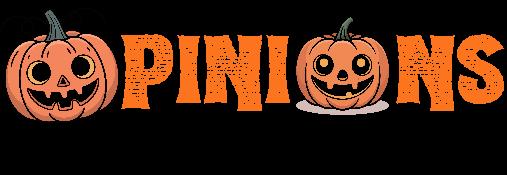
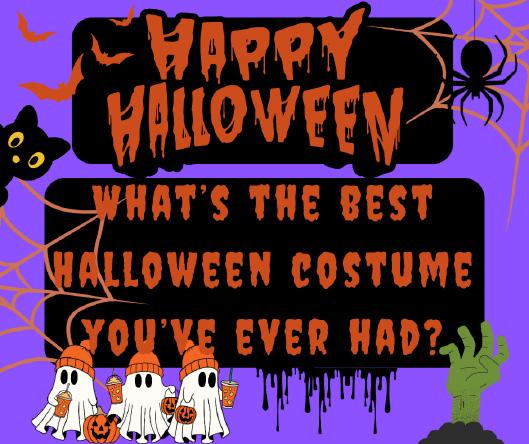
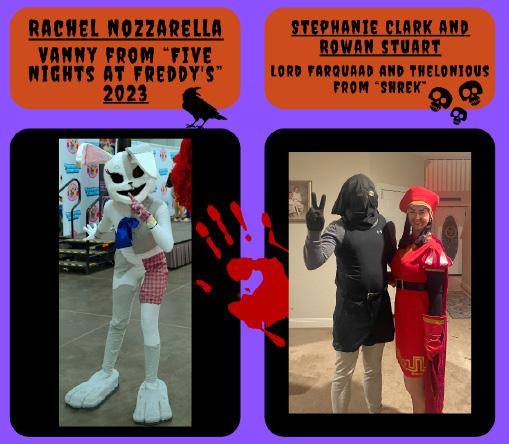

Reducing the environmental impact of Halloween, one costume at
BY JOCELYN KAELIN jpkaelin@vwu.edu
These days, it is so easy for people to click a few buttons and order brand new shiny, sequined Halloween costumes that are worn once and never again, but this takes a toll on the environment.
Companies like Shein and Amazon use polyester, nylon and other fossil fuel-derived materials to make poorly constructed costumes, and they are difficult to repair or rewear because they degrade too quickly.
Instead of buying a cheap costume firsthand, consider thrifting or using online second resale sites
a time

impact, find more unique
Jocelyn is a sophomore studying environmental studies and Hispanic studies. Currently, she is vice president of Marlins Go Green, stage managing VWU’s production of The Thanksgiving Play and a member of Camerata and Vox Vera. In her free time, she enjoys hiking, singing and hanging out with her friends and family.
Letter to the Editor
Alumnus expresses his thoughts on the university’s name change.
John Wesley wasn’t exactly a saint. He built his movement by shaming followers for hours, breaking them down emotionally and then offering salvation as the only way out. To be fair, he did advocate for the poor and disenfranchised; establishing schools, clinics and outreach programs — but all of it was tied to conversion and strict adherence to Methodist discipline. Help came with strings attached.
Two hundred years later, universities bearing his name operate on a similar model: prestige, belonging and access in exchange for money. The difference? The Batten family invests voluntarily and transparently, funding programs that actually benefit students.
Testimonials on the alumni “Stop Batten University” petition reveal the real problem: alumni clinging to nostalgia and moralizing about wealth, even though most contribute only modestly relative to the scale of gifts that sustain the university.
If you aren’t funding the school at a level
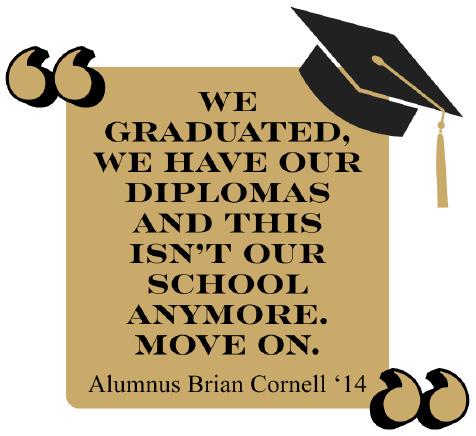
that shapes its future, you have limited standing to dictate who does — or who gets naming rights. Wesley sold salvation; the university sells education. Both were transactions dressed in morality. We graduated, we have our diplomas and this isn’t our school anymore. Move on.
- Brian Cornell ‘14
BY ASHLEY CAYON acayon@vwu.edu
Every semester starts the same way: notebooks, new caffeine habits and the same classroom speech: ‘No ChatGPT, no AI, automatic zero.’ It’s like deploying the smoke detectors before the first match has even been struck.
But ask yourself: Is this “protection” a safeguard for education or just a comfortable illusion that keeps us from facing the challenging yet necessary dawn of a new era?
We’ve been through this before. The calculator was going to “ruin math.” Google was going to “kill research.” And now, apparently, AI is coming for our critical thinking. There’s always a new
villain, but the story never changes. Technology gets smarter and we eventually catch up.
AI isn’t the villain here. It’s the reality check. If the machine can breeze through the work, maybe it’s time we stop blaming the tools and start rethinking the tasks.
Instead of banning it, why not teach it? Professors could show students how to check AI’s facts, challenge its tone and use it as a creative partner instead of a shortcut. Because the truth is students are already using it, just quietly. If universities want to keep up, they could start by integrating AI literacy into existing classes. Imagine a composition course where students have to compare their own
writing with an AI draft. Or, a research class that teaches how to prompt responsibly and verify sources, not just copy and paste whatever sounds convincing.
Even simple changes, like requiring reflection paragraphs on how students use AI or what they learned from it, would shift the focus from punishment to practice.
The goal shouldn’t be to catch students using AI, but to teach them how to use it better, because this technology isn’t going anywhere.
The only question now is whether higher education will keep pretending it’s 2019, or start preparing students for a world that actually exists.
Fear won’t keep up with technology, but

understanding might. If education is supposed to prepare us for the real world, it can’t do that by pretending the future doesn’t exist. Maybe it’s time to stop warning students about AI and start figuring out how to work with it. It’s about the moment human instinct and technology move in sync. The students who can question AI, argue with it, remix it and still
school. She’s a Miami girl turned
make it sound human are the ones who will actually understand what learning looks like now. That’s not cheating, that’s evolution with Wi-Fi. If higher education wants to stay relevant, it needs to take its own advice and adapt. Try the new thing. Get messy. Ask better questions. Because AI isn’t the death of curiosity; it’s proof we still have some left.

muralist. She’s currently serving on the Virginia Beach Public Arts Committee, the Gen MOCA Advisory Board and teaching
Tidewater Arts Outreach. She’s got plenty to say and even more to learn, so she’s here to listen, create and keep the conversation fresh.
like Depop or Poshmark to reduce your environmental
pieces, rewear your costume and save some money!
Ashley Cayon|Marlin Chronicle
At 37, Ashley is juggling motherhood, marriage and full-time
Virginia Beach creative: photographer, graphic designer, artist and
with
Isaac Fick|Marlin Chronicle Photographs courtesty of Marlins photographed.
Ashley Cayon|Marlin Chronicle
Isaac Fick|Marlin Chronicle
Jocelyn Kaelin|Courtesy


Senior finds voice in first children’s book ‘Rise Up Ronnie’
“I sat down and wrote like three different stories and I didn’t really like any of them. Honestly, I just didn’t feel like it conveyed whatever I was actually feeling. When I was on the plane, I was like ‘my brain is flowing right now,’” Smith said. “I took my phone out and just started writing on my notes app, and I knew this was the story.”
Smith’s father had first encouraged him to write a children’s book, so when the plane landed, he immediately called both his parents to tell them he had finally done it.
“Rise Up Ronnie” follows characters Ronnie Rodgers and his best friend Ajax Garcia who aspire to make their first basketball team. When Ronnie goes through trials of doubting his ability to accomplish this, his friend Ajax reminds him that he can.
“Obviously, everyone goes through things, whether that be related to confidence or anything. It doesn’t have to be basketball related, it can just be life related. Parents are not always going to be around. They’re not always going to be able to help you through a situation. So I think writing it for kids and showing them to have friends to lean on, as opposed to parents or teachers is important because, as kids, you’re at elementary school eight hours a day, and that’s your environment,” Smith said.
Omari DeVeaux, Smith’s teammate of four years, said Smith is a best friend and brother to him.
“When he gets to basketball practice, he’s outgoing, he’s loud and outspoken. So I would say that side shows a lot from the aspect of Ajax, the friend who’s helping Ronnie find his confidence,” DeVeaux said. After DeVeaux suffered an injury he said, Smith was always there to
encourage him and keep his spirits up.
The publishing journey began in July 2025, right as Smith was preparing for his senior year. He said balancing class registration, graduation plans and booking meetings wasn’t easy.
David Macedo, head basketball coach, said he’s watched Smith grow on and off the court. He said the story reflects Smith’s own personality: a thoughtful, connected teammate with a natural passion for storytelling and making people feel good.
“Austin did an internship last spring, and I think it really stirred his intellect as he’s figuring out what he wants to do when he graduates. I think this is a passion of his. The sky’s the limit for him. I think he’ll continue chasing his passion, and that has to do with writing stories and sharing his journey with others,” Macedo said.
Smith’s publisher is located in Maryland, but he was living in Northern Virginia at the time, so the majority of communication took place over the phone. Additionally, the illustrator was located in the Philippines, so Smith said the whole process required patience to navigate. Smith said the publishing industry can be complex and requires authors to stay involved in every step of the process.
“I had to literally write out page one, the words, and then I wrote out kind of what page one looks like, just to let them have a reference to draw it.” Smith said the art process took almost two months, which he described as “really tough” because of the anxious wait.
Smith said the publishing process will be different for every author, but patience is key. He said the final product is a reflection of the hard work put into it. “Rise Up Ronnie” was published in September 2025.
“It’s a feel-good book. It’s about friendship. My wife has actually read it to her preschool class and shared it
with a lot of the teachers,” Macedo said.
Smith said the response to “Rise Up Ronnie” has been overwhelming with love, with families reaching out to share how the story has inspired their children. He said that hearing his parents express pride in seeing him become a published author at 22 has been “a surreal experience.”
“He’s always talked about how he wanted to write, write, write. He tells me that he journals all the time. So I guess finally publishing it has opened up a new,… fiery passion for him to make more books,” DeVeaux said.
Beyond the book itself, Smith’s writing connects to the larger topic of representation in media. As part of his senior project, Smith’s been studying how Black authors are often underrepresented in mainstream outlets such as The New York Times. He said that major platforms play a big role in shaping which stories reach readers.
“It’s one of the most powerful mediums as far as subscribers and viewers. So if a big medium is not giving people these stories, you can’t read what you can’t see. And that’s an issue for me, especially being someone who is a Black author,” Smith said.
For Smith, the lack of coverage of Black authors and Black culture is about more than just visibility, but it’s about the stories that go untold.
“I’m just trying to make sure people are learning about us. We have stories and experiences that are very unique to us and that can be shared with everyone. People think that just because it’s a Black story, you need to be Black to understand it, but it’s just a story,” Smith said.
Smith’s book “Rise Up Ronnie” can be ordered through his website austintheauthor.com or contact austinsmithauthor@gmail.com for purchases and book reading events. Smith can be followed on Instagram @austinsmiththeauthor.
Playing in the Old Dominion Athletic Conference means bringing the best every week and finding a way to do it again the next.
For the coaches at Virginia Wesleyan University, ODAC competition is less of a season and more of a grueling test of consistency and endurance. Every match carries weight. There are no off days, easy opponents or shortcuts to success in the ODAC.
The ODAC includes 14 schools across Virginia and surrounding states, each fielding programs with long-standing traditions of success. Programs like Washington and Lee University have a championship pedigree, with 20 ODAC championships in Women’s Volleyball.
“Even if you’re the top team in the conference playing the bottom team in the conference, you got to expect it’s going to be a battle and a grind,” said Shane Kohler, head coach of Men’s Soccer.
Chris Francis, head coach of Men’s Baseball for the past 11 years, has seen the ODAC’s competitiveness up close. “It’s the winningest conference in the country in Division III … a couple years ago, one of our last-place teams had a 20-win season, there’s just no easy weekend off, right?”
The ODAC breeds intensity due to the rivalries across the conference, built on a

foundation of competition and respect.
As an added bonus, each school in the ODAC is within driving distance, meaning rivalries get a local boost.
“Our guys grew up playing with a lot of guys that end up at [Randolph-]Macon or Lynchburg or [Hampden-]Sydney,” Francis said. “It’s sort of a friendly rivalry, but very heated during competition.”
“Randolph-Macon, CNU, Bridgewater, all have players that our kids have played with in high school and in clubs. So definitely fuels that fire a little,” said Karissa Cumberbatch, head coach of Women’s and Men’s Volleyball.
While there might be respect, there isn’t much love lost in the ODAC. For
Men’s Soccer, the rivalries run deep and wide. “I think it’s every single team in the conference,” Kohler said. Baseball doesn’t have one clear-cut rival either, though certain matchups bring extra intensity.
“Hampden-Sydney’s given us fits the last few years,” Francis said.
“We really do look at each game that we play in the ODAC as the game of the week,” Francis said.
To win in the ODAC, the formula is simple: prepare, prepare, prepare. “As far as the mental performance goes, I mean, we just got to know that every game we’re going into battle. That’s how we prepare,” Cumberbatch said.
“There aren’t many games in the ODAC
that you can just walk in and be blind and, you know, get a win.”
However, even with the maximum preparation, sometimes things don’t go the Marlins’ way in conference play. “You don’t play your best 100 percent of the time for every point,” Cumberbatch said.
“We’ve gotten really good at winning ugly and understanding that we don’t have to be perfect,” Cumberbatch said. This season, Women’s Volleyball seems to have cracked the code for success in the ODAC. The Marlins are 26-1 overall, and 9-0 in ODAC play.
The energy of a home crowd helps, too.
“There’s a ton of home-field advantage,” Kohler said. “About 40 percent of the students here are student-athletes ... There’s just a lot of camaraderie amongst all the students.”
That same energy that provides an advantage also defines VWU athletics. “I love being here because I’m a really small- town kid,” Cumberbatch said. “I get that tight community on campus where kids know my name, even if I don’t know them.”
That energy extends to every program. Francis said that’s what makes VWU different. Wesleyan has the “best people I’ve ever been around,” Francis said. “Other places may have more stuff than us, but they certainly don’t have the relationships that we have.”
Austin Smith|Courtesy
Smith published “Rise Up Ronnie” and received physical copies in September. The art process of the book took nearly two months, making it an anxious wait.
Eli Casey|Marlin Chronicle

Championship or bust? Women’s Volleyball dominates
The Marlins hold a 26-1 record and are 9-0 in ODAC play.
BY BAILEY GRAY
The setter gracefully leaps toward the net, sending a high-arching set to the outside hitter who times the perfect moment to explode off the floor, release a powerful swing and slam the ball into the opponent’s court, executing a clean kill. The outside hitter returns to the floor and joins her celebrating teammates.
The VWU Women’s Volleyball team began the season with 21 straight wins. The team remains undefeated in the conference, despite having one loss to Salisbury University, and is ranked No. 22 in the NCAA DIII Women’s Volleyball Rankings.
This season, Setter Niya Nash, a junior, reached 1000 assists and Outside Hitter Hannah Smith surpassed 1000 kills and 1000 digs, which were astonishing milestones.
Graduate student Hannah Smith is a Virginia Beach native who played for the D1 Beach Elite Volleyball Club before being recruited by her hometown university, VWU. During her time here, she has received honors such as First-Team All-ECAC, First-Team All-Conference, First-Team All-Region and First-Team AllState.
Nash began her volleyball journey at 13 years old. After achieving 1000 assists, she now strives to reach her new goal of 2000 in the current season.
“It’s definitely a big accomplishment because I was right there with 972 in high school, so it was something that I was glad that I finally got to do,” Nash said.
Women’s Volleyball Head Coach Karissa Cumberbatch attributes the team’s success to the positive energy from the new players and the team’s traditionally strong serve and pass game.
“Everybody wants the same thing out of the season, but trust and chemistry are huge in a sport like volleyball,” Cumberbatch said.
Cumberbatch said that Nash and Smith have significantly contributed to the program’s success and are respected leaders. “I’m really proud of Niya and Hannah for their accomplishments, and there’s more to come. They’re both here for another year, and that’s exciting. I think

they will be in the program’s top record holders by the time they are done here. They both deserve it, and they both work hard,” Cumberbatch said.
She said that they both embody what it means to be a fierce leader. “They’re both pretty resilient, whether they are playing well or not. They always find a way to positively affect the game,” Cumberbatch said.
Nash attributes her success to trusting her hitters and the strong team chemistry. “I wouldn’t reach it if they weren’t putting down the ball, so all of it goes to them,” Nash said.
Even during intense games, Nash said she enjoys the competitive atmosphere. “I love pressure. I’ve played best in highpressure situations. When it’s a tight game, it is not time for mistakes and goofing off; it is time to lock in because I know that is what I’m capable of,” Nash said.
Nash chose Virginia Wesleyan for its supportive coach and family-like environment. “I have 17 other sisters here,” Nash said. “We care about each other so much off the court. Even when we don’t have to be with each other, we are.”
During recruiting, Nash said that she knew VWU was the right choice because of Coach Cumberbatch’s efforts to envision
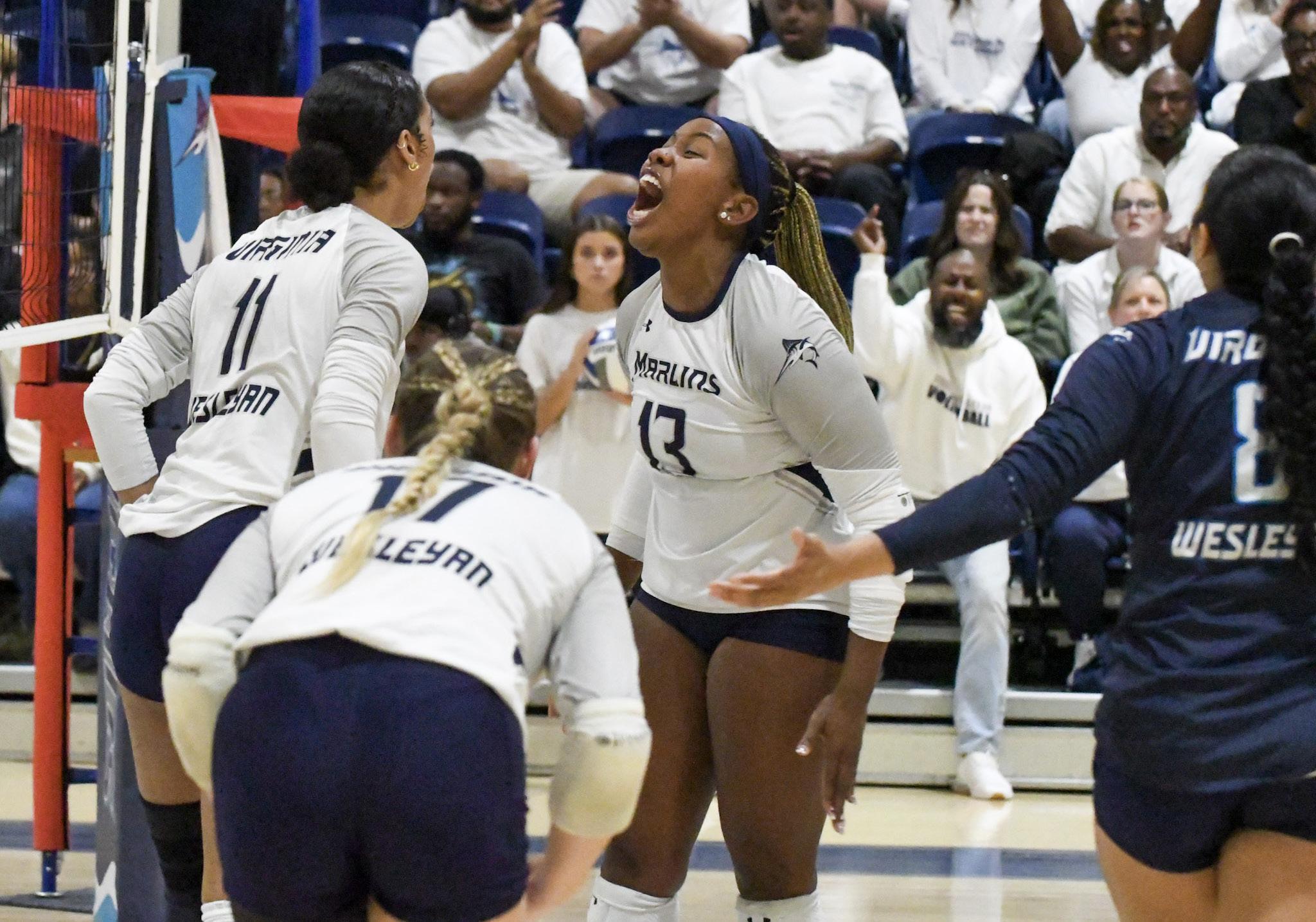
her future. “I could feel that she wanted me here for me, not just because of volleyball, and her persistence really showed in the tournaments when she was recruiting me.
Cumberbatch said she started watching Nash play during her sophomore year of high school at club tournaments. “I knew I liked her, and I knew that she was what we needed,” Cumberbatch said.
Cumberbatch’s early admiration for Nash’s talent grew into deep respect for her leadership. Nash proved that her impact extended far beyond her performance on the court.
“Niya does everything outside of the gym that you need a captain to do, and she takes on a lot of the responsibility as far as the team and how they’re getting along, workouts and holding people accountable,” Cumberbatch said.
Sophomore Kathryn Liles, a setter and defensive specialist on the team, sees Nash as a powerhouse player and a teammate she seeks to emulate. “I definitely look up to Niya a lot as a mentor, and especially as another setter. She’s been very inspiring for me and someone that I strive to be like and play like,” Liles said.
After Smith graduated with her bachelor’s degree, she realized she needed to come back to VWU and tend to some unfinished business on the volleyball court.
“I went to Salisbury at the beginning of this year and then transferred back to Virginia Wesleyan because I’ve already broken a couple of records here, so I wanted to add on to it. I felt like I could break a lot more, so I didn’t want to give up that opportunity,” Smith said.
Smith said she is a very driven athlete and happy to hit two major milestones this season, hoping to lead the team to the championship this year. “I’m all about beating my prior goals, so I want to do better than we did last season,” Smith said.
Coach Cumberbatch emphasized that Smith’s leadership plays a crucial role in contributing to the team’s chemistry and performance. “Hannah is a great physical leader,” Cumberbatch said.
Smith said she aims to always be a reliable teammate and handle pressure so that nerves do not get the best of her. “I’m a calm source for everyone on the court, especially if it’s a chaotic situation,” Smith
said. “I tune out everything that’s around me, whether we are at home when there’s a bunch of people in the stands, or we are at an away game and the student section is heckling me.”
According to her teammate Liles, Smith is someone the team can count on during games and she was super excited to celebrate her for this accomplishment. “She is a great player. She’s probably one of our core players on the team,” Liles said. Nash expressed how much she enjoys having Smith on the court in front of her and noted how they must work together to succeed in matches. “Hannah feeds into my assists and I feed into her kills at the same time,” Nash said.
Even after a loss, Smith viewed it positively, believing that it could help prevent the excessive pressure of being undefeated going into conference playoffs.
“We have one loss, but I think that needed to happen to get us back on track with our goals, so I’m not upset about it,” Smith said. “We want to prove that we should be ranked and that we should be competing against these top-level teams.”
To Nash, leading by example is the most important way she can show the team expectations. “I feel like showing the aggression, my relentless pursuit, and grit, especially to the new girls, goes a little bit longer than saying it. You can say all you want, but if you’re not doing it, what’s going to make them want to do it?” Nash said.
Nash and Smith envision their goals of making it one step further than last season’s team. “We went to the championship last year and fell short, but it’s a different group with girls who are here because they want it,” Nash said.
Liles shared similar thoughts on postseason play. “I think we are trying to take it one game at a time. We definitely do see ourselves in the tournament, but there is still a lot of work to be done to get there. We’re focusing on this moment, finishing out the regular season and moving on to ODACs,” Liles said.
As the playoffs are approaching, this team is on the grind of making every practice count. You will not want to miss the Marlins this postseason.
Sportshead: Adam Silver wants the NBA global
BY ROMAN FOSTER
Adam Silver, commissioner of the NBA, was recently interviewed by Bloomberg on the NBA’s future. In the interview, Silver discussed the league’s future plans of expanding throughout the entire world. However, before the NBA can globally expand, it needs to make changes to ensure its product doesn’t fall behind the other major American sports leagues. The NBA needs to focus on its local product before trying to go worldwide.
The two biggest issues the NBA currently faces are the health of its star players and the amount of travel. The league has to face these issues before adding international games. If I were the commissioner of the NBA and I wanted to make the league ready for international expansion, I would make some changes.
This season, NBA teams will travel an average of 42,000 miles for games (Statsurge). This is already very taxing on athlete bodies, before adding cross-continental flights. To fix this and lower the amount of total distance traveled in the states, I would expand the league and change how divisions work. After moving the Timberwolves and Spurs, I would add a team in Seattle and a team in Las Vegas. Doing this would expand the total number of teams to 32 as well. Why would these cities get expansion teams? Las Vegas has hosted the NBA’s summer league for five years, meaning it has a relationship with the league. Vegas also has an arena that is already built and ready for a team to play in. Seattle used to have a franchise, the Seattle Supersonics. Even
though the Sonics haven’t existed for a while, they are still culturally relevant for the city. Finally, both of these cities also have franchises with the NBA’s sister league, the WNBA.
Now that the NBA has 32 teams in the league, I would reform the conferences and divisions into a system similar to the NFL. I would make each conference have four divisions with four teams each. Each team in a division would play each other, and their record against each other would determine the division winner. In this system, division winners would be rewarded with a playoff birth and homecourt advantage. With these changes, division games would be around half of a team’s total games, which would drastically shorten the total travel distance for a team.
The next issue of player health will be benefited greatly from the decrease in total travel distance. The league has had a star player health issue for many years and my solution to fix it would be to decrease the total number of games played in the regular season, while increasing the number of games played in between division rivals.
The NBA regular season consists of 82 games, but it should be closer to 60 total games. If each team played 60 games, and 30 of them were in-division, it would increase the importance of the regular season. Having fewer games would also have the added benefit of promoting rivalries between teams in a division. By putting playoff implications on regular season games and increasing the frequency of times division rivals play each other, this would foster an environment of iconic moments.
As an avid fan, it’s frustrating to hear talks of global expansion, when the product we get still has so many flaws that seem easy to change. Silver is having talks with investors about his dream for an international league when there are still things to fix here in the states. While I don’t think I’m the smartest person for the job, I believe my changes to scheduling and player health would improve the product.
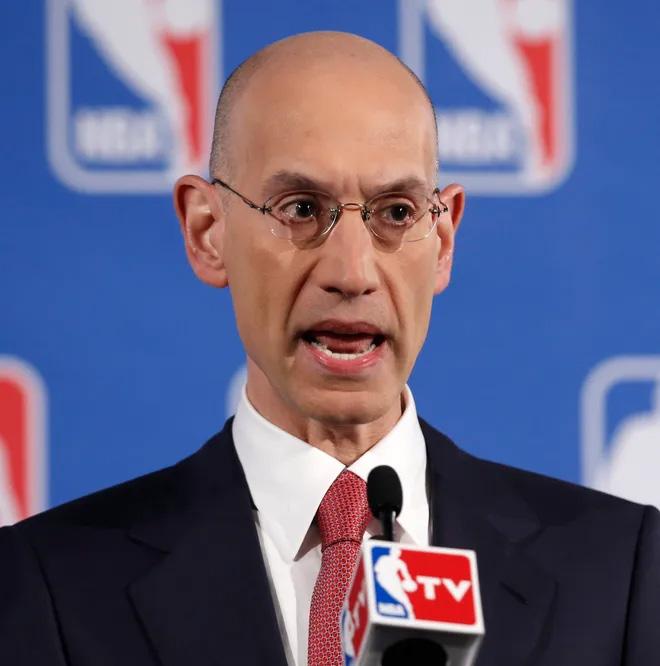
Emilie Dajc|Marlin Chronicle Junior Niya Nash and sophomore Brianna Clay celebrating at the net.
Emilie Dajc|Marlin Chronicle
All smiles from the Marlins as they 3-0 sweep conference rival Bridgewater.
Kathy Willens of


Curating Creativity
Muse Paintbar offers fun and engaging classes, allowing customers to develop a new creative outlet.
REVIEW
BY CALEE LUKOWSKI crlukowski@vwu.edu
Anyone who knows Sarah Richards, a senior at VWU and illustrator for The Marlin Chronicle, knows that one of her many passions is art. An only child, Richards got into art “because it didn’t really require anybody else to be there.”
This certainly is no longer the case, as Richards currently works at the Virginia Beach location of Muse Paintbar where she teaches paint and sip classes.
With the weather turning colder, it might be time to find some activities inside. Muse Paintbar offers the perfect spot for a fun day out and a creative outlet for the stress of the semester. Whether you are looking for a group activity or a solo day out, Muse is a great spot. With so many fun options to choose from, Muse offers a space to make a fun painting.
The space is nothing short of a burst of color. From paintings to murals to bulb lit signs Muse has created a space that not only inspires but is also an implosion of creativity. As soon as you walk in, there is no denying the kind of space you just entered. After being greeted by wonderful staff, you are directed to your easel and given an apron to prepare for the fun.
“When I first walked in, I noticed all of the art on the walls, and I thought it was so cool how they had them displayed everywhere,” junior Camryn Owens said.

While you wait for the class to begin, you can enjoy drinks, alcoholic and non-alcoholic, or grab a bite to eat from Muse’s kitchen. After settling in, you can enjoy a moment to relax, sip a drink, and get acquainted with your new colorful environment.

Muse provides all materials for the class, including canvas, paint, brushes and amazing instructors. You don’t need to be an artist to enjoy your time at Muse. “I also noticed how neatly the stations were set up with everything we’d need for the session, which I thought was nice,” Owens said.
It’s more than just some murals on the walls that make for such a fun and enjoyable environment. The staff at Muse are all incredibly friendly and helpful.
“It’s always a great environment,” Kaira Smith, a staff member at Muse, said. Smith attributes this environment to the workers, as well as to the customers, and enjoys “getting to mingle” with people everyday.
Richards also speaks on the great team at Muse, attributing the great work environment, saying “we have a really good team here, like, everyone works together and helps everyone out.”
Something she enjoys more, though, is the customers’ experiences at Muse.
“Sometimes people will really doubt the process, and it’s really a big ‘trust the process’ moment. So to see them happy when it’s all completed is really cool,” Richards said.
That’s something special about taking a painting class at Muse; it’s unlike any class you could ever take. The instructors walk you through the process of creating
a masterpiece, including offering up some tricks of the trade. Classes at Muse are a perfect mix of strict instructions and the freedom to be creative.
“I would 100% go again, especially if it was for a special occasion. It would be so much fun to do it with a big group of friends,” Owens said.
Muse offers classes at many different times and days so there is something to fit everyone’s schedule. There are also a wide range of different designs available, from themed paintings to match the season to landscapes to fun everyday designs, there’s something for all tastes.

Calee Lukowski|Marlin Chronicle Muse Paintbar is the epitome of a paint studio with splashes all over the workshop.
Camryn Owens|Courtesy
Senior Sarah Richards leads a group in painting a mountain sunset landscape.
Calee Lukowski|Marlin Chronicle Camryn Owens (LEFT) and Calee Lukowski (RIGHT) posing in the studio after the class. Behind is one of many walls covered with artwork, including a column with the instructor’s selfportraits.

The hunt for fall festivities is over
BY J’DN TAYLOR jataylor1@vwu.edu
Hunt Club Farm offers fun fall activities, from pumpkin picking to Halloweenthemed festivities. Between the lively crowds, friendly staff and photogenic surroundings, Hunt Club Farm’s Harvest Fair continues to be a seasonal favorite.
Whether it’s feeding goats, exploring the pumpkin patch or taking a scenic hayride, the fair captures the essence of fall in every detail. This time of year also brings a variety of pumpkins and seasonal plants for sale, allowing guests to take a piece of autumn home with them.
The fair offers plenty of space to roam and enjoy the scenery, making it enjoyable whether visiting with friends or exploring solo. The animals each have their own personalities, and every turn reveals a charming view or new activity.
Hunt Club Farm’s annual Harvest Fair brings together the nostalgia of fall, the warmth of community and the joy of family-friendly fun. At $18 per person (ages two and under free), admission covers the experience of the petting farm, treewalk adventure and unlimited farm-tour hayrides. Located on London Bridge Road, the farm welcomes guests daily from 10 a.m.

to 5 p.m., offering a seasonal escape filled with local flavor and festive spirit.
“I wanted to bring my wife and daughter out to spend some family time,” visitor
Joshua Irizarry said. “It’s my wife’s birthday, so that’s another reason we came out today. I also wanted to show my daughter the cows here!”
Because the Harvest Fair provides excitement for everyone; families, couples and groups of friends gather each year to enjoy pumpkins, live music and cozy autumn weather surrounded by friendly faces and farm animals.
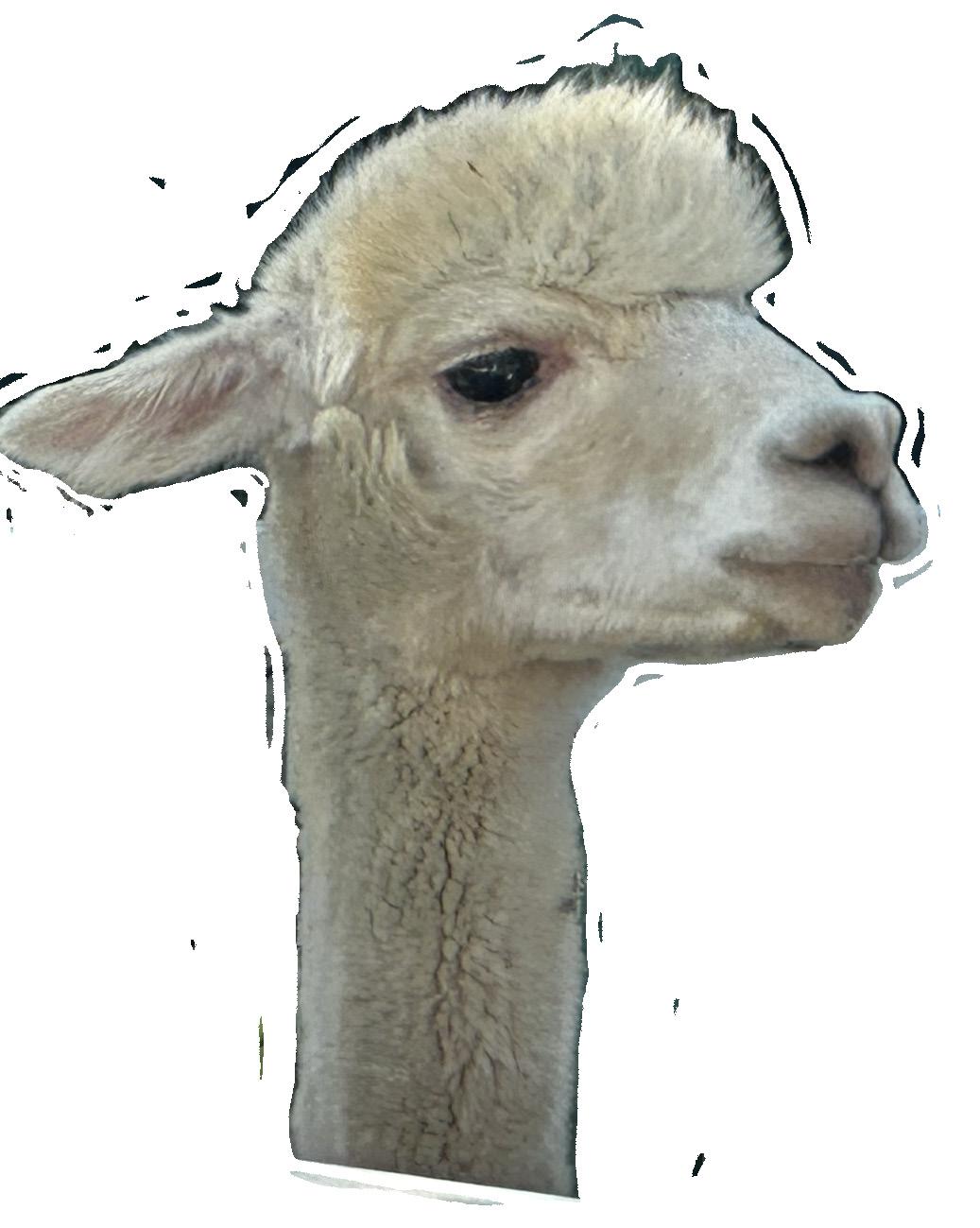
For Irizarry, the goats stood out as the highlight of the day. “They have so much personality and are fun to engage with,” he said, noting that his daughter adored the cows. He also praised the hayride for its scenic route and mentioned the Festival of Fear as a must-visit for adults looking for Halloween thrills.
“The workers make sure you’re enjoying your time and make you feel welcomed,”
Friends Aliya K. and Bryalee B. were drawn to the fair by the beautiful fall weather. “We mainly wanted to look for something to do,” Aliya said. “The

weather is really nice today, so we thought it would be nice to come here.” Their favorite attraction was the bird exhibit, which they recommended to new visitors.
“It’s very relaxing, calming and beautiful here,” Bryalee said. “Going to pumpkin patches can be very busy and overwhelming, but coming here, it was very peaceful.”
Hunt Club Farm’s staff also show appreciation for the farm’s welcoming atmosphere. Robin C., who works at the pony rides section, described her experience simply: “Working here is fun and comfortable.” When asked what animals visitors should see first, she recommended the Highland cows and the ponies. Robin used three words to describe the farm: “friendly, fun and beautiful.”
While the event delivers on atmosphere and charm, some areas could benefit from small improvements. Parking can become crowded during peak hours, and certain attractions draw longer lines that might require patience. Additionally, with the

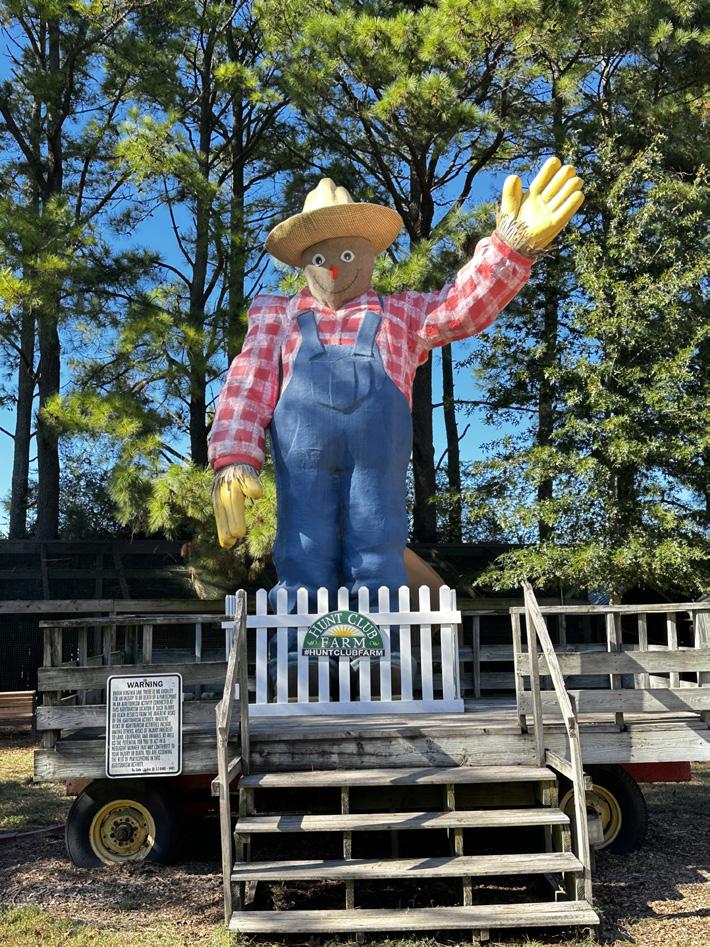
farm’s popularity, it can be difficult to find quiet moments during busier weekends.
Between Sept. 27 and Nov. 2, the farm hosts its annual Harvest Fair, a celebration filled with family fun, seasonal treats, and autumn charm. As the leaves change and the cool breeze sets in, visitors can enjoy the fair’s festive atmosphere, then return after dark for the Festival of Fear, which runs through Nov. 2 and brings spooky thrills to complete the Halloween vibe.
This family operated and owned business not only provides fun attractions during the fall, but they also offer “educational field trips … and agriculturebased entertainment” through their “Petting Farm, BirdWalk Aviary, TreeWalk Adventure and pony rides.”
Regarding other seasonal festivals, they have the Haunted Hunt Club Farm, also called the Festival of Fear, Easter Egg Hunt and Spring Fling. For updates, ticket information, photos or schedules, visit their website at huntclubfarm.com or their Instagram page at @huntclubfarm and Facebook at Hunt Club Farm.


J’dn Taylor|Marlin Chronicle
Aside from fruits and vegetables, Hunt Club Farm also has an extensive indoor store.
J’dn Taylor|Marlin Chronicle Hunt Club Farm sells a large collection of pumpkins and gourds.
J’dn Taylor|Marlin Chronicle The farm is filled with lively decorations for the fall and Halloween season.
J’dn Taylor|Marlin Chronicle
Gabrielle Barnett|Marlin Chronicle
Gabrielle Barnett|Marlin Chronicle
